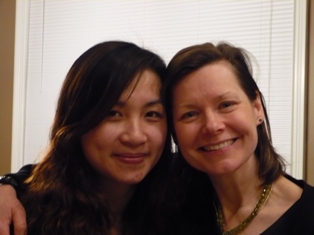|
At my local library, I heard John Breen tell the story of how
he had wanted to help his friend, a doctor taking care of children in
Africa. John had wanted to send crayons and coloring books to the
children, but his friend said that they were too hungry to color, that
what they really needed was food. John went on to create the website freerice.com. Students go
to this website to test their English vocabulary and grammar, and their
correct answers donate grains of rice to the poor. I love using this
kind of story in my classroom; one person can make a profound
difference.

Kim Hallback (right) poses
with Pei-yi Liu (left), a student at Indiana University who assisted her
with developing this piece.
I have found several true stories like this on the program
Sunday Morning, a CBS news
program. For example, there was a story about a woman who started a
school for refugee children. Another story was about a woman who founded
Beads for Courage. Volunteers make glass beads for children who have
cancer. For each particular medical procedure the children go through,
they receive a specific colored bead. These beads form necklaces and
serve as reminders of the procedures. Showing their necklace, a colorful
badge of courage, the children are able to tell their stories to
others.
Another website is kiva.org, a microcredit loan
organization. On this site, there are stories of people around the world
who need money to start their small business. An individual can donate
$25 toward a business of his or her choice. After the business becomes
successful, that $25 is returned to the individual, or it can be
redirected to another person in need.
An intermediate level book that I have taught is The White Zone (2012) about two boys, cousins, in Iraq. The story takes place during the Iraqi War, and although there is no graphic violence depicted, one still can feel the horror of war. The Shiite boy’s uncle is killed by a Sunni, and the boy’s anger is directed at his cousin, who is half Shiite and half Sunni. The ending has a surprising resolution. Another book I have used for my advanced students is called Architects of Peace: Visions of Hope in Words and Images (2000). It has writings about peace from Coretta Scott King, Mohammad Yunus, Nadja Halilbegovich, and others.
An activity that gets discussion going is the trust walk. One
student is blindfolded, and the other stays at the partner’s side and
tells him or her which direction to go in, how many steps to take, and
where the stairs are. The students then switch roles, and afterward
there is a class discussion about the importance of trust to establish
peace.
Quotes get students voicing their opinions. I put up a quote
and leave out a word or a phrase from the quote, and at times the
students’ guesses are more powerful than the original quote! The
students then share their impressions. Here are just a few quotes that
initiate dialogue:
- “Out beyond ideas of right and wrong doing, there is a field. I will meet you there.” Jalaludin Rumi
- “It might be a good idea if various countries of the world
would occasionally swap history books, just to see what other people are
doing with the same set of facts.” Bill Vaughan
- “Underground nuclear testing, defoliation of the rains
forests, toxic waste. . . . Let’s put it this way: If the world were a
big apartment, we wouldn’t get our deposit back.” John Ross
- “If you want to learn to love better, you should start with a friend who you hate.” Nikka, age 6
- “Above all nations, is humanity.” University of Hawaii motto
References
Marsden, C. (2012). The White Zone. Minneapolis: Lerner Publishing Group.
Collopy, M., & Gardner, J. (Eds.). (2000) Architects of Peace: Visions of Hope in Words and Images. Novato, CA: New World Library.
Kim Hallback has been fortunate to be able to teach peace education in intensive English programs at Indiana University and Soka University of America. Applying peace education outside of the classroom, Kim has worked as a counselor of adolescents, an assistant in therapeutic horseback riding for disabled children, a teacher of cooperative activities at a peace camp, and a leader in presenting UNICEF’s Children’s Rights Exhibit at California State University at Channel Islands.
|

